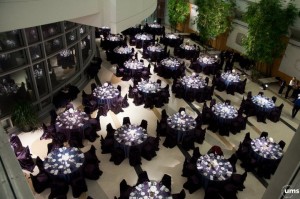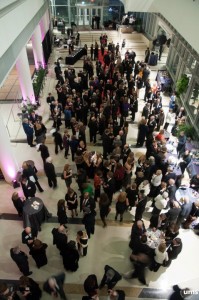Interview: Ford Honors Program featuring JLCO and Wynton Marsalis
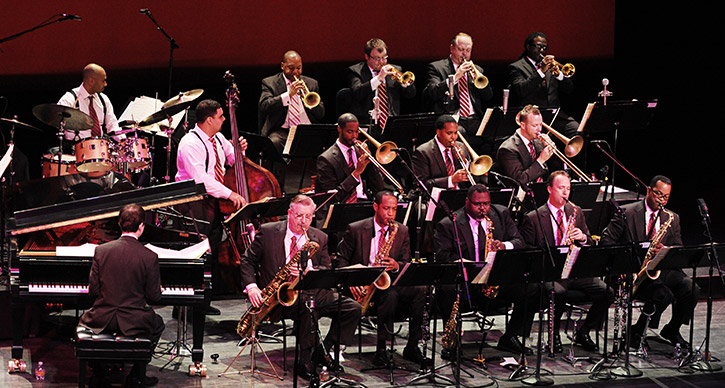
Photo: Jazz at Lincoln Center Orchestra and Wynton Marsalis in concert. They’ll perform in Ann Arbor on March 30, 2014. Photo by Frank Stewart.
Each year, the UMS Advisory Committee (an organization of over 60 volunteers who contribute over 7,500 hours of service to UMS each year) works together with UMS staff on the UMS Ford Honors Program Gala. FHP is our annual benefit that supports UMS’s Education & Community Engagement Program, which provides free or low-cost education and community engagement activities focusing on K-12 students, teachers, teens, university students, families, adults, and cultural communities. Funds raised from the Gala make it possible for UMS to impact nearly 20,000 youth, educators, and community members each season.
This year, we’re excited to honor Wynton Marsalis and the Jazz at Lincoln Center Orchestra, artists who have a long history with UMS, and also a deep commitment to education.
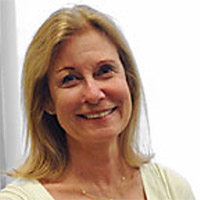 We sat down with Cheryl Cassidy, who’s leading the FHP efforts this season. Cheryl is a resident of Ann Arbor and a professor in the English department at Eastern Michigan University.
We sat down with Cheryl Cassidy, who’s leading the FHP efforts this season. Cheryl is a resident of Ann Arbor and a professor in the English department at Eastern Michigan University.
Caroline Kagan: What are you most excited about in this year’s program?
Cheryl Cassidy: I’m always excited about Ford Honors. We have been going, my late husband and I, and my daughter also, for the past thirteen, fourteen years. For me and for my family it’s always been a really exciting thing to be with people who are interested in the arts and to be a part of that community.
Of course I’m excited this year because Wynton Marsalis is just such a stellar performer. To be part of planning the whole thing is exciting, too. It’s fun, and it’s nice to be a contributor in a way that is very meaningful.
CK: Have you attended Jazz at Lincoln Center Orchestra and Wynton Marsalis performances in the past? If so, what do you like about them?
CC: You know, I thought about this question, and I was trying to think, what is it? I think a part of it is that not only does Wynton Marsalis excel at what he’s doing in his art, but he also has this very uncommon ability to transcend his medium. He goes beyond what’s predictable, in terms of musical boundaries, as does the Jazz at Lincoln Center Orchestra. Along with that there’s this inclusivity that happens, so that the audience and the performers feel a part of the whole experience. That’s both a very fragile and a very unusual thing.
Secondarily, I’m excited because Wynton Marsalis and the Jazz at Lincoln Center Orchestra have such an impact on our community. They’ve created possibilities for educational experiences for students, particularly those students who, under normal circumstances, would not be able to attend a concert like this. Of course the donors for this performance and gala are then supporting the continuation of those educational programs.
CK: Related to that thought, what do you think the Ford Honors Program brings to the community at large?
CC: I think the Ford Honors Gala in general and this particular performance and honoree in particular really reflect our community’s devotion to the arts. It’s not just a singular devotion. I think it’s very multifarious. In other words, it includes universities like the University of Michigan and Eastern Michigan University, the community in Ann Arbor, Ypsilanti, and beyond in the region. Wynton Marsalis and the JLCO really appeal to a great number of people. The gala reflects our commitment and our devotion to these stellar performers and indicates how much we value their creativity and how it enriches our lives.
CK: You also chaired the committee that planned the 2006 Ford Honors Program, which honored jazz pianist and composer Dave Brubeck. What did you learn from that experience, and how have you incorporated those insights as you plan for this Ford Honors Program?
CC: I think the most important thing that I learned and that I experienced was the importance of having a really good team, a team of people who are dedicated and who are highly invested in the event, and we’re very lucky to have a great team working on this year’s FHP.
CK: Now I’m going to ask you a very hard question. Why do you support the arts?
CC: That is a hard question and that involves so much emotion. I think that for me, personally, the arts really enrich my life. And I think that the arts are part of how we are human. We have to incorporate the arts into our lives, because that makes us better people, better community members, better people in the world, because the arts transcend cultures. They are for the world and for everyone.
I buy into all that, but I think also my late husband was just fiercely devoted to UMS. He wanted to go to every concert and I sort of had to say, “We can’t do it all!” He was really a person who treasured the idea that UMS was here in Ann Arbor, as do I. So I’ve been very conscious of that legacy, as has my daughter, and I think that’s part of it as well.
Interested in learning more about this year’s Ford Honors Program? Visit our FHP event page where we’ll keep the most up-to-date information about the gala.
At Ford Honors Program in 2013
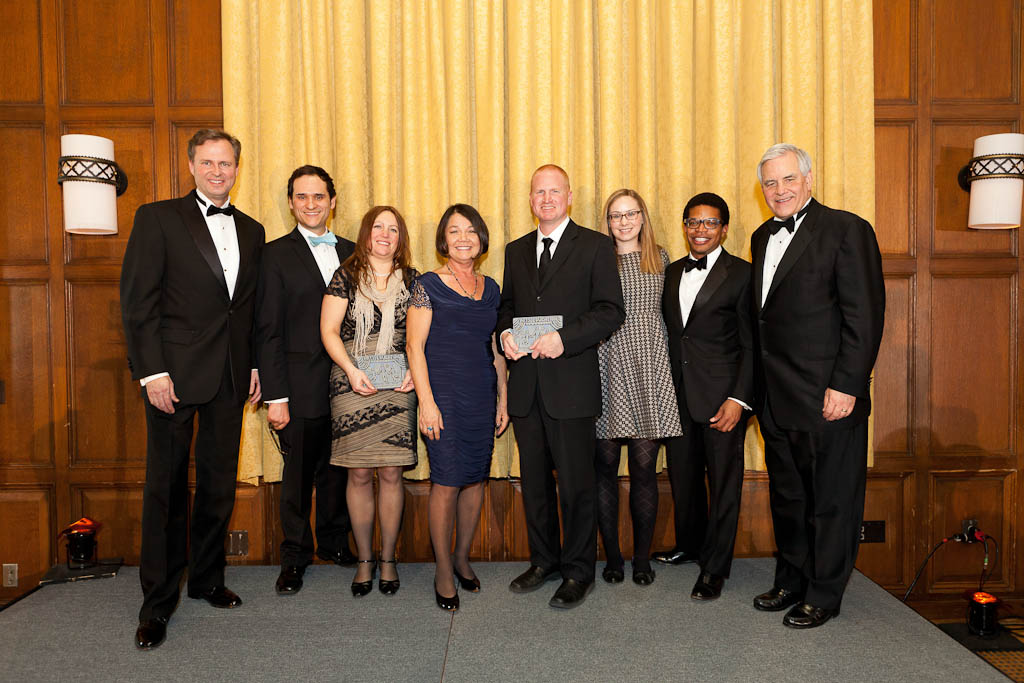
Photo: Mark Gjukich Photography.
In this photo, our 2013 DTE Educator and School of the Year Matt Kazmierski of Ypsilanti Public Schools and Laura Machida (music) and Meredith Giltner (art) of Carpenter Elementary School receive their awards. Each year, UMS asks the southeastern Michigan community to help us choose the awardees. We want to recognize educators and learning communities doing great work integrating the arts throughout the K-12 curriculum. The award is presented at our annual Ford Honors Gala, which benefits our education and community engagement programs.
This season’s gala takes place on Sunday, March 30 and will also honor Wynton Marsalis and Jazz at Lincoln Center Orchestra with the UMS Distinguished Artist Award.
Remembering Pianist Van Cliburn
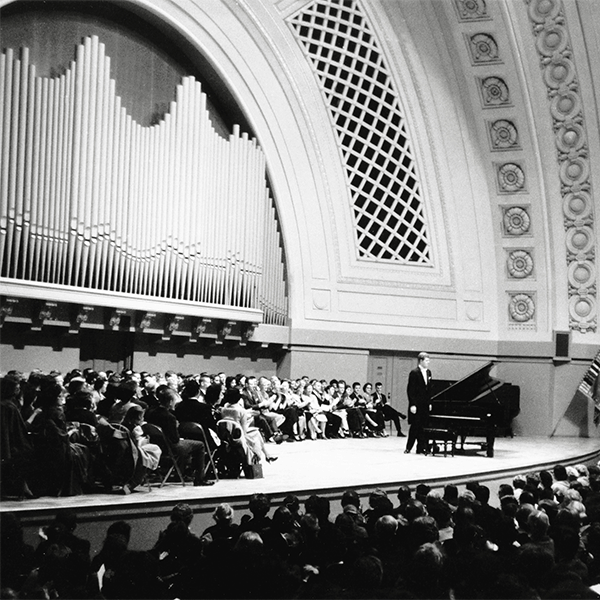
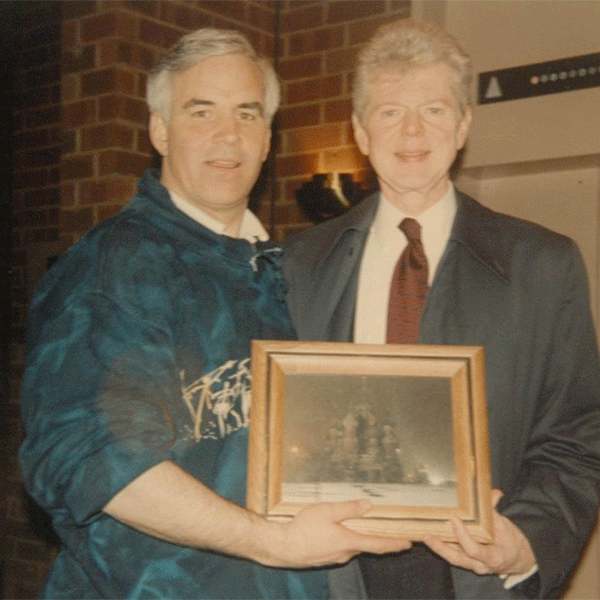
Photos: L: Van Cliburn performs for a capacity audience including “stage seating” in Hill Auditorium in March 15, 1968. R: UMS president Ken Fischer with Van Cliburn during his visit to Ann Arbor for the first Ford Honors Program in 1996.
When Penny and I were teens at Interlochen in 1961, we had the thrill of accompanying this ‘rock star’ of classical music as members of the National High School Orchestra when he performed the Tchaikovksy piano concerto in the Kresge Auditorium at Interlochen. It was this piece that sealed his winning the first Tchaikovsky competition in Russian in 1958 at the height of the Cold War between Russia and the U.S.
I served on the Interlochen board with Van in the early 1970s. He maintained a long relationship with Interlochen for many years and provided scholarship support to many students.
He received the UMS Distinguished Artist Award at the inaugural Ford Honors Program on May 11, 1996. The photo above was taken of Van and me outside of Sloan Plaza in Ann Arbor where Van stayed in the apartment provided by Don Chisholm. I gave him a photo I had taken the previous November when I was in Moscow’s Red Square. It’s a photo of St. Basil’s Cathedral taken in a snowstorm.
UMS commissioned Ann Arbor singer-songwriter Dave Barrett to produce a 4-minute video on Cliburn’s career that we showed at Ford Honors. Barrett set the video to the music of “One Shining Moment,” the famous sports song that Barrett wrote and that has accompanied the highlight film following CBS’s coverage of the NCAA National Championship basketball game for the past 27 years. The song has been performed by such artists as Luther Vandross, Teddy Pendergrass, Jennifer Hudson, and Barrett himself. It’s Barrett who performs it in the video.
Van Cliburn had “One Shining Moment” at the Tchaikovsky competition so it seemed appropriate to use this music with a few word changes as a backdrop to the video. The images in the video are from a 1996 documentary directed by Peter Rosen titled “Van Cliburn: Classical Pianist.”
I will remember Van as a warm, gracious person who loved people, loved the arts, and loved life.
Yo-Yo Ma and the Silk Road Project: Musical Journeys
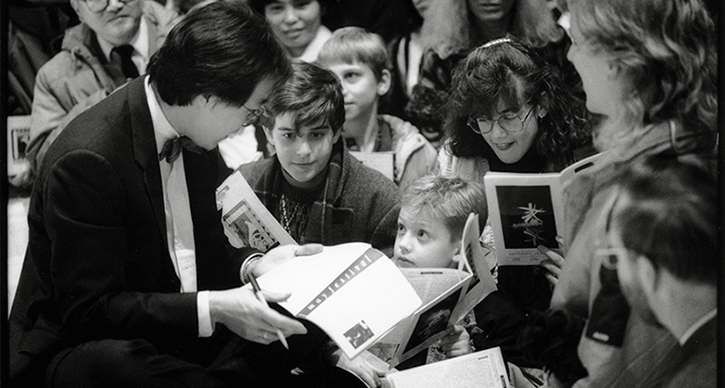
Photo: Yo-Yo Ma sits on the stage and autographs programs for students at Hill Auditorium in 1991.
With their March 16 concert at Hill Auditorium, Yo-Yo Ma and the Silk Road ensemble receive the 2013 UMS Distinguished Artists Award, and Yo-Yo Ma is a name known to almost anyone even casually acquainted with classical instrumental music. Sheer longevity has helped Ma to this point—his performing career began in 1961, at the age of six, and he has an instinct for connecting with general audiences that was second nature to the great virtuosi of the past but isn’t seen so much anymore.
Yet this Parisian-born, Chinese-descended, and for all that thoroughly American cellist has reached a level beyond mere popularity. “Distinguished artist” covers it pretty well. How did he get here? Few would nominate him on purely technical grounds; he does everything well that he needs to, but it’s a keen ear that can identify his playing from its sound alone. Audiences are quick to respond to his personal warmth, and no one should discount that. But it’s a quality he shares with many other musicians.
Most artists follow trends, a few even set them. But rare indeed are the ones like Ma for whom each individual concert is part of a larger, even a lifelong utterance. Yo-Yo Ma’s music brings ideas from a hundred years ago, and it explores others that are absolutely new, and in which he is indeed a pioneer. His music-making carries with it history of ideas, and in this lies its enduring appeal.
Something entirely new in the history of concert music
The Silk Road Project, an incarnation of which appears at UMS’s March 16 special event, was founded in 1998. It’s something entirely new in the history of concert music: not really an ensemble, for as an ensemble it is always changing. Instead, it’s an organization, a framework for collaboration, an ongoing series of programs and educational enterprises—in a word, an idea.
The Silk Road, which also had an important maritime component, was a network of trade routes connecting Asia, the Mediterranean, and Africa from antiquity until the Renaissance era. It was a conduit for much more than silk and other luxury goods, bringing, for a start, Buddhism to China, ancient Greek art to Central Asia and points east, and Indian religions and finally Islam to Indonesia. Why do statues of the Buddha look Greek? The artistic ramifications of these developments, stretching over more than a millennium, are countless, and each new Silk Road Project recording or performance brings the feeling that the surface has only been scratched.

Image courtesy of UNESCO.org.
The Silk Road Project is indeed something new, yet it’s something old as well. It’s difficult for modern audiences to put themselves in the place of those in the late nineteenth century, when lines between classical and popular music were not so firmly drawn, and when a virtuoso was often a player who brought a whiff of exotic lands. With the Silk Road Project, Yo-Yo Ma is in part reflecting on his own heritage and on the many cultures in its orbit. Classical music has always relied on the physical presence of the virtuoso to keep it in touch with the music of the wider world and avoid losing itself in insular delusions of linear progress, and looked at in one way, Ma is the heir to a musician like violinist Pablo de Sarasate, whose repertory traced a semicircle from Spain to Venice Eastern Europe around classical music’s increasingly Germanic core.
Sarasate performs:
Yet, for all that, Yo-Yo Ma is a product of the idealistic middle twentieth century, when classical music seemed able to spread a kind of enlightenment. He made his name not with Asian music but with Bach’s suites for solo cello, following the mold of an artist whose influence on him has been a bit obscured by the fact that their styles are different: Pablo Casals. Ma played under the 90-year-old Casals in the Marlboro Festival Orchestra in Vermont, and Casals went on, at 95, to write a Hymn to the United Nations (with text by W.H. Auden), and Yo-Yo Ma numbers among his honors that of official United Nations Messenger of Peace.
A Hymn to the United Nations:
The Silk Road Project rests on this foundation of idealism. It has been the major artistic decision of Yo-Yo Ma’s middle age, and it weaves together strands of culture from wide ranges of space and time. Each Silk Road Ensemble concert brings something of exotic cultures, of classical idealism, and of new world fusions, yet each one is different. As an explorer of world music Ma is unusual and fresh; as a visionary who sees how world music relates to the classical tradition and its capacity for historical reflection, he is a unique treasure. He has a keen eye for talent, a healthy disregard for genre, and a willingness to try new things that is nothing short of marvelous in the later stages of a classical career. Distinguished, indeed.
A Beautiful Evening with “The People’s Diva” at the Ford Honors Gala
For those who attended the stunning 4pm Hill Auditorium recital last Sunday, you already know that Renee Fleming received the 2011 UMS Distinguished Artist Award. What you might not know is what happened afterward…! People are still talking…
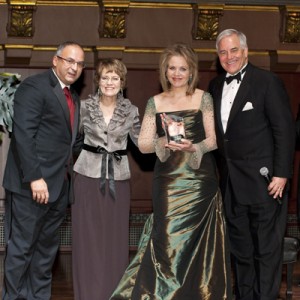
From left: Jim Vella, Ford Motor Company Fund & Community Services, Mary Sue Coleman, President, University of Michigan, Renée Fleming, Ken Fischer, President, UMS
As part of honoring Ms.Fleming, 325 guests fêted her with a champagne reception and dinner at the Biomedical Science Research Building. The BSRB atrium was transformed into the perfect space to celebrate the gifts and achievements of “The People’s Diva”.
The warm, inviting and DIY-chic atmosphere was decked out in plums and grays, highlighted by cozy colored lights. The guests of all ages, equally decked out in “Creative Black Tie”—the latest trend in formal dressing, were captured by local photographer Steve Kuzma. Of course, Ms. Fleming had changed into yet another glorious ball gown, this time a strapless steel gray long dress, topped by a fur wrap of the same color. Gorgeous as always. She was a gracious honoree, just as she had been on the stage at Hill. Funny, lively, captivating—she made certain to greet all the guests, new friends and old, who approached her at the dinner. She also participated in the ceremony honoring the DTE Energy Foundation School of the Year – Ann Arbor’s Angell Elementary – and Educator of the Year – Roberto Clemente’s Joey Parins.
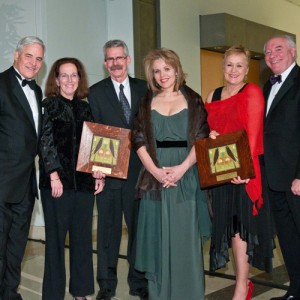
From left: Kenneth C. Fischer, UMS President; Joan Singer and Gary Court, accepting the DTE School of the Year award on behalf of Angell Elementary School; Renée Fleming; and Joey Parins, DTE Educator of the Year with Fred Shell, President of the DTE Energy Foundation
The shimmering lavender table linens, dressed with white rose topiaries by Ann Arbor florist Tom Thompson, provided the perfect backdrop to a gourmet dinner by Opus One Detroit. After sumptuous hors d’oeuvres, a dinner of braised short ribs, parmesan encrusted halibut and eggplant napoleon followed. A delicious lemon and blackberry tart finished off the meal. Post-dinner dancing to the Rhythm Society Orchestra, a 15-piece swing band, closed out the evening…but not before guests had a chance to nibble on chocolate chip cookies and take home a Renee Fleming CD as another fond memory.
The Ford Honors Gala celebrates an artist honoree each UMS season and raises funds for UMS’s Education & Community Engagement Programs. The event gives guests the opportunity to experience artists up close, a chance to meet like-minded lovers of the performing arts and have a marvelous time doing both! Stay tuned for more information on next year’s event, or, if you’d like to get on the mailing list right now, please send an email to cstraub [at] umich [dot] edu.
A Chat with Deb Clancy, UMS’s DTE Energy Foundation Educator of the Year
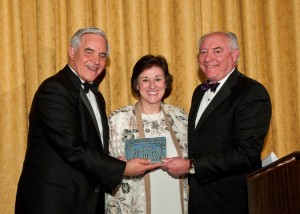 At the Ford Honors Program Gala Dinner on Saturday night, UMS presented its DTE Energy Foundation Educator of the Year Award to Deb Clancy from the Washtenaw Intermediate School District.
At the Ford Honors Program Gala Dinner on Saturday night, UMS presented its DTE Energy Foundation Educator of the Year Award to Deb Clancy from the Washtenaw Intermediate School District.
As the former Washtenaw Intermediate School District (WISD) Liaison to our UMS Youth Education Program, Deb Clancy has been a model steward, partner, and leader. Along with her “bend-over-backwards” brand of support, she provided insightful counsel when making programmatic and strategic decisions. Though Deb transitioned roles within WISD this season and is no longer the UMS liaison, her spirit of helpfulness and the support beams of her contributions remain embedded in our program and in our partnership with WISD.
Omari Rush, UMS’s Youth Education Manager, caught up with Deb recently to talk about arts education and how the schools are adapting to their new realities.
OR: You’ve worked with UMS for five years as the WISD liaison to the Youth Education Program. What did you particularly enjoy about this partnership?
DC: I really admire and commend UMS’s commitment to offering diverse programming across the spectrum of the arts: both to K-12 students and to educators in southeast Michigan. Its willingness to leverage boundary-spanning partnerships to realize creative projects for school communities is a model for what all educators will have to do in the coming years. As funding sources become less obvious, we’ll all need to work harder to find the opportunities in partnerships to secure additional support or funding for education-related endeavors.
OR: Tell us what pressing academic issues are facing the schools now.
DV: At the county level our focuses are on, of course, math and literacy, along with other areas such as early childhood education and personalized learning. While data from the MEAP testing show increases in student achievement in reading and math, we’re still working on closing achievement gaps between students of different socio-economic levels and between students of different ethnicities. The arts are certainly a factor in achieving these goals. Through our partnership with UMS we’ve been able to bring teaching artists to the area that provide our teachers with an array of creative strategies that help us improve student success and reach students as individual and unique learners. One example of an arts-infused workshop this year was “Math + Dance: Exploring Sequence and Combinations.”
OR: What do you see as the biggest opportunities in education?
DC: The national conversation in education is about 21st century skills; those essential skills that our children need to succeed as citizens and workers in the 21st century. Re-thinking content delivery so that learning goes beyond the traditional school walls and beyond the traditional school textbook is one area of opportunity for the general education community. The opportunity for the arts is to identify meaningful and proven methods for fitting into this framework. While we know that an arts-infused education is closely linked to student achievement, development, and engagement, there is ample opportunity to further refine and clarify these arts-related benefits and to create specific techniques for content delivery and integration.
OR: What would you like folks who don’t know UMS to understand about the program?
DC: UMS searches the world for renowned programs that focus on student involvement in the arts, programs that provide our students with academic and life skills; the programming really brings the arts to life for students of all ages. As a UMS teacher of the year shared three years ago, “UMS delivers the world, without you ever leaving the county.” I completely agree! Since 1990,UMS has touched and changed the lives of over two hundred thousand students through arts involvement. It’s really quite amazing!


